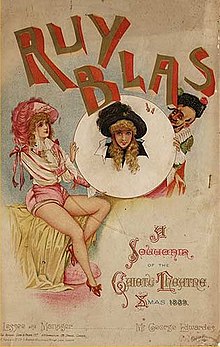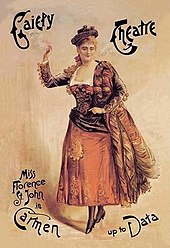This is an old revision of this page, as edited by Ssilvers (talk | contribs) at 17:25, 29 December 2010 (→History: ce). The present address (URL) is a permanent link to this revision, which may differ significantly from the current revision.
Revision as of 17:25, 29 December 2010 by Ssilvers (talk | contribs) (→History: ce)(diff) ← Previous revision | Latest revision (diff) | Newer revision → (diff)
Burlesque, also known as travesty, is a genre of entertainment. Before burlesque became associated with striptease, it was a form of musical and theatrical parody in which an opera or piece of classical theatre is adapted in a broad, often risqué style very different from that for which it was originally known.
History
Burlesque originated around the beginning of the Victorian era, when the social rules of established aristocracy and working-class society clashed. The genre often mocked such established entertainment forms as opera, Shakespearean drama and ballet. The burlesque was a logical descendant of ballad opera and other forms of comic musical entertainments.
Madame Vestris produced burlesques at the Olympic Theatre beginning in 1831 with Olympic Revels by J. R. Planché. In the early burlesques, the words of the songs were written to popular music in the same way that had been done earlier in The Beggar's Opera. Later in the Victorian era, burlesque mixed operetta, music hall and revue, and some of the large-scale burlesque spectacles were known as extravaganzas. W. S. Gilbert wrote five opera burlesques early in his career, beginning with Dulcamara, or the Little Duck and the Great Quack (1866), the most successful of which was Robert the Devil (1868). In the 1870s, Lydia Thompson's burlesque troupe, with Willie Edouin, became famous for their burlesques, by such authors as H. B. Farnie and Robert Reece, both in Britain and the U.S.

Burlesque became the specialty of London's Gaiety Theatre and Royal Strand Theatre from the 1860s to the early 1890s. In the 1860s and 1870s, burlesques were often one-act pieces running less than an hour and using pastiches and parodies of popular songs, opera arias and other music that the audience would readily recognize. Beginning in the 1880s, composers like Meyer Lutz and Osmond Carr contributed original music, and the shows were extended to a full-length two or three act format. Nellie Farren, as the theatre's "principal boy" and Fred Leslie starred at the Gaiety during that period, and Leslie wrote the libretti for many of these pieces under his pseudonym, "A. C. Torr". John D'Auban choreographed the Gaiety burlesques from 1868 to 1891. In the early 1890s, musical burlesque went out of fashion, and the Gaiety Theatre's focus changed to the new genre of Edwardian musical comedy.
The dialogue for many of the burlesques was written in the form of rhymed couplets, and was full of bad puns. For example, in Faust up to Date (1888), a couplet reads:
- Mephistopheles: "Along the Riviera dudes her praises sing."
- Walerlie: "Oh, did you Riviera such a thing?"
By the 1880s, the genre had created some rules for defining itself:
- Minimal costuming, often focusing on the female form.
- Sexually suggestive dialogue, dance, plotlines and staging.
- Quick-witted humour laced with puns, but lacking complexity.
- Short routines or sketches with minimal plot cohesion across a show.
Etymology
The name "burlesque" is derived from the Italian burla, which means "jest." The form began as comic parodies of well-known topics or people.

The term "travesty" combines the Latin words trans-, meaning "across, over" and vestere, "to dress or to wear". According to the Oxford English Dictionary, the word travesty originally meant "to disguise by changing costume" specifically "in the attire of the opposite sex". In modern literary theory, the word continues to hold this meaning in reference to dramatic works: transvestism onstage is referred to as travesty. In particular "travesty roles" are dramatic roles in which the sex of the character is opposite that of the performer.
Examples of burlesque
Ruy Blas and the Blase Roue made fun of the play Ruy Blas by Victor Hugo. The title was a pun, and the worse the pun, the more Victorian audiences were amused. Other Gaiety burlesques included Robert the Devil (1868), The Bohemian G-yurl and the Unapproachable Pole (1877), Blue Beard (1882), Ariel (1883, by F. C. Burnand), Galatea, or Pygmalion Reversed (1883), Little Jack Sheppard (1885), Monte Cristo, Jr. (1886), Pretty Esmeralda (1887), Frankenstein, or The Vampire's Victim (1887), Mazeppa, Faust up to date (1888), Carmen up to Data (1890), Cinder Ellen up too Late (1891), and Don Juan (1892, with lyrics by Adrian Ross).
Well known ragtime travesties include The Russian Rag, by George L. Cobb, which is based on Rachmaninoff's Prelude in C-sharp minor, and Felix Arndt's Lucy's Sextette based on a sextet from Lucia di Lammermoor by Donizetti.
To compete with vaudeville and revues like the Ziegfeld Follies, burlesque became increasingly racy after 1900.
See also
Notes
- ^ Information about dramatic burlesque
- "Theatrical Humour in the Seventies", The Times, 20 February 1914, p. 9, col. D
- Stewart, Maurice. 'The spark that lit the bonfire', in Gilbert and Sullivan News (London) Spring 2003.
- "Mr. D'Auban's 'Startrap' Jumps". The Times, 17 April 1922, p. 17
- Biographical file for John D'Auban, list of productions and theatres, The Theatre Museum, London (2009)
- Lubbock, Mark. "History of British musical theatre", The Complete Book of Light Opera, New York: Appleton-Century-Crofts, 1962, pp. 467-68
- ^ Jarrett, Michael. "Music Hall, Vaudeville, and Burlesque (1843)"
- "Travesty". Oxford English Dictionary (2nd ed.). 1989.
- Anne Hermann (1989). "Travesty and Transgression: Transvestism in Shakespeare, Brecht, and Churchill". Theatre Journal. 41 (2). The Johns Hopkins University Press: 133–154. doi:10.2307/3207855.
- Hollingshead, pp. 57–58
- Hollingshead, pp. 14 and 55
- Programme for Carmen up to Data
- Adams, pp. 254–55
- Hollingshead, pp. 63–64
- Arthur Lloyd Music Hall site (on Gaiety) Cuttings accessed 01 Mar 2007
References
- Adams, William Davenport (1904) A dictionary of the drama Chatto & Windus
- Hedin, Thomas F. (2001) The Petite Commande of 1664: Burlesque in the gardens of Versailles, The Art Bulletin
- Hollingshead, John. (1903) Good Old Gaiety: An Historiette & Remembrance London:Gaity Theatre Co
- Frye, Northrop. (1957) Anatomy of Criticism: Four Essays. Princeton: Princeton University Press
- Description of early burlesques in America by historian John Kenrick
External links
- Encyclopaedia Britannica 1911: "Burlesque"
- Information about Burlesque from the PeoplePlay UK website
- Further information from the PeoplePlay UK website
- History of Burlesque at Musicals101.com, The Cyber Encyclopedia of Musical Theatre, TV and Film
- "A Guide to Classical Burlesque - Funny Ha Ha or Funny Peculiar?" Allan, K., The Curious Adventures of Kittie
- Behind the Burly Q. 2010 documentary film by Leslie Zemeckis